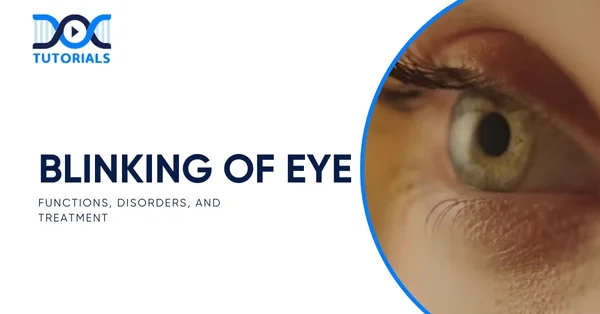Blinking of Eye: Functions, Disorders, and Treatment

Eye blinking is the body’s reflex action, meaning it occurs automatically. Still, at the same time, you also blink whenever you want to. The rate of eye blinking varies with age; a baby blinks twice a minute, and teenagers blink 15 times a minute, while an adult blinks about 14–17 times a minute. The rate can go up or down based on several reasons. An increase can be caused by dust, smoke, glare, or a foreign body in the eye, leading to irritation. Stress, fatigue, anxiety, allergy, dry eye, and infection are also recurring causes of hyperblinking.
Understanding all these physiological mechanisms is essential for medical students attempting the NEET PG exam, as they provide a foundation to learn further higher-level concepts. Want to know more? Read further for an in-depth analysis of eyes blinking!
What is Blinking of the Eye?
Blinking is an automatic, involuntary eye movement reflex. It is controlled by the autonomic nervous system, which makes the activity take place involuntarily without any thought. But you also have the option of blinking voluntarily at any given time. Blinking is of three separate categories:
- Spontaneous Blinking: It is the most prevalent category, which happens on its own, like breathing.
- Voluntary Blinking: It is when you blink intentionally. For example, you can blink deliberately now. (In fact, you probably just did!)
- Reflex Blinking (Corneal Reflex): This form of blinking occurs when something comes too close to the eye. Your corneal reflex activates whenever you detect danger, such as when you’re caught in a dust storm or when a ball passes by a few inches from your face.
What are the Functions of Blinking of the Eye?
Blinking has a number of critical functions that contribute to good eye health, eye maintenance, and good vision. These include:
- Moisturising and Hydrating the Eye Surface: The cornea, which is the transparent front side of the eyeball, needs a good cover of tears so that it can be smooth and transparent. This tear film is replenished by blinking, and this allows the light to travel normally in order to see clearly.
- Eliminating Foreign Particles and Dust: Blinking will clean out the foreign particles such as pollen, dust or other small irritating things and reduce eye irritation, allergy and infection.
- Spreading Tears Evenly Over the Cornea: Each blink will distribute the moisture across the eyes so that they do not dry up and become uncomfortable, especially after intense computer usage or under dry conditions.
- Preventing Dryness of the Eyes: Tears consist of water, mucus, and oil, which form a protective film over the eyes. Blinking slows the evaporation of tears caused by wind, air conditioning, or low-humidity environments.
- Stimulating the Lacrimal Glands to Produce More Tears: This helps maintain adequate eye moisture.
- Protection of the Eyes from Sudden Light or Sudden Movement: This reflex safeguards the eyes against possible harm or severe glare.
What are the Disorders That May Lead to Hyper Blinking of the Eye?
Even though hyper blinking is usually not dangerous, there are certain neurological conditions that may be the underlying cause. Such cases are rare but include:
- Wilson’s Disease: This is due to an accumulation of excess copper in the body, which can accumulate in organs like the brain. Neurological symptoms can follow, such as a lot of blinking, facial twitching, clumsiness, and tremor.
- Multiple Sclerosis (MS): MS is a central nervous system disorder which may cause vision difficulties, coordination issues, muscle weakness and disability to control some associated body movements, such as excessive blinking.
- Tourette Syndrome: A disorder that is manifested by spasms of the muscles and vocalisation twitches. If these movements involve the muscles around the eyes, they can lead to repetitive or pronounced blinking.
What are the Common Excessive Eye Blinking Treatment Options?
There are various reasons why an individual may be blinking eyes excessively, from mild irritations to neurologic diseases. Treatment is done by management of the underlying cause and pain relief. These are:
- Behavioural Therapy
Behavioural therapy works best as a treatment for people who blink voluntarily excessively. It enhances the patient’s awareness of their blinking pattern and employs habit-reversal techniques to reduce frequency.
- Medications
Doctors can also cure spasmodic eye twitch or twitching caused by Tourette syndrome using muscle relaxants or anticholinergic drugs. In allergic-blinking, antihistamines are most often used to cure the condition.
- Botox Injections
These injections relax overactive muscles close to the eye. Botox can significantly inhibit spasmodic involuntary blinking and twitching, primarily in instances where the underlying reason is spasm of the muscle.
- Stress Management
Stress management courses can be helpful in instances where stress or tension causes excessive blinking. These may include relaxation training, reducing fatigue, and identification and control of precipitants of stress on an individual basis.
- Surgery
Surgery would only be the last resort in case every other method has failed. In that case, one can have a doctor remove some muscles, tissues, or nerves that are causing too much blinking.
FAQs About Blinking of Eyes
- What can cause a lack of blinking?
A slower rate of blinking can be associated with neurological illnesses such as Parkinson’s disease or Alzheimer’s disease. Head trauma, such as concussions or physical trauma, and illness, such as migraine headaches or dry eye syndrome, can cause damage to the brainstem and change the blink reflex.
- What happens when you can’t stop blinking?
In many cases, frequent blinking does not indicate a serious health problem. Nevertheless, when the blinking is persistent enough that it interferes with your day-to-day activities, you will need to see a healthcare expert. They will carry out an intensity eye test so as to diagnose the cause. Depending on the diagnosis, treatment will be done.
- Can a person go without blinking?
The cornea, the transparent front of the eye, contains no blood vessels and thus depends on the tear film for oxygen. When the eyes do not blink, the cornea bulges, resulting in blurry vision, sensitivity to light, and pain.
- How to stop excessive blinking habits?
Here is how you can stop your excessive eye blinking problem:
- Apply eye drops daily to keep eyes lubricated.
- Keep taking frequent breaks while reading or in front of the screen.
- Avoid environments that irritate eyes, like smoking areas.
- Schedule regular check-ups for your eyes with your eye care professional.
- What are the side effects of rare blinking?
Rare blinking, or not blinking at all, can lead to numerous issues. These include:
- Corneal inflammation
- Reduced supply of essential nutrients to the eyes
- Dryness of the eyes resulting from the lack of tear film replenishment
- This increases the risk of eye infection because of debris in the eyes and the lack of oxygen to the cornea
Conclusion
In conclusion, maintaining healthy blinking habits is essential for preserving good eye health. Not only does blinking lubricate and clean the surface of our eyes, but it also keeps us from having dry eye syndrome and the pain that comes with it.
With some simple tricks like adhering to the 20-20-20 rule, being hydrated by drinking plenty of water, and applying lubricating eye drops, we can ensure better eye lubrication and avoid the experience of dryness and pain as much as possible.
Also, for the NEET PG aspirants, a good understanding of ophthalmology is key for a proper rank. Thus, at DocTutorials, we offer comprehensive NEET PG study materials, video classes by experts, and quick revision programmes (QRP) to assist aspirants in excelling.
Aiming for a top rank? Join our NEET PG course today!
Latest Blogs
-

NEET PG Exam 2025- Date, Pattern, Marking Scheme, Subject Wise Weightage, and Exam Mode
NEET PG Exam 2025 is the ultimate gateway for medical graduates aspiring to pursue postgraduate courses in medicine, including MD,…
-

INI CET Exam 2025: Your Roadmap to Success – Key Topics, Strategies, and Lessons from Last Year’s Papers
The INI CET exam is more than just a test; it’s a significant milestone for many medical students aiming to…
-

INI CET Exam Success: Previous Year Question Papers & Ultimate Guide – INI CET PYQ
One can feel overwhelmed while preparing for the INI CET (Institute of National Importance Combined Entrance Test). A vast syllabus,…




